

A WildlifeLink Project . . . . .
"Piccaninny Plains"
Cape York, Far North Queensland
a collaborative partnering with
Australian Wildlife Conservancy
PO Box 8070
Subiaco East WA 6008
Tel (08) 9380 9631
Email: info@australianwildlife.org
http://www.australianwildlife.org/sanctuaries/piccaninny-plains-sanctuary.aspx
A new model for conservation - founded by the late Martin Copley (AM) in 1991, AWC is now the largest private owner of land for conservation in Australia.
AWC owns and manages 27 sanctuaries throughout Australia covering more than 4.6 million hectares, home to over 533 bird species (88% of all Australia’s terrestrial species) and 207 mammal species (72% of Australia’s mammal species).
Australian Wildlife Conservancy (AWC) was established more than 10 years ago - with the strategy to:
-
Establish sanctuaries by acquiring land and through partnerships with landholders; and
-
Implement practical land management – feral animal control and fire management – informed by good science.


Piccaninny Plains is jointly owned and managed by Australian Wildlife Conservancy ("AWC") and The Tony & Lisette Lewis Foundation.
It represents an exciting new model for collaboration in the private conservation sector in Australia, being jointly owned and managed by the two organisations with AWC responsible for delivering land management and science programs.
Covering more than 170,000 hectares (420,000 acres), Piccaninny Plains lies in the heart of Cape York Peninsula in Far North Queensland.
It is a region of global significance for conservation with stunning ecological diversity containing rainforests, woodlands, wetlands and grasslands.
Cape York was connected to New Guinea for much of the last 250,000 years until submerged due to post glacial sea level rise about 6,500 years ago. As a result Piccaninny Plains is home to a rich biological diversity strongly influenced by the interchange of fauna with New Guinea.
Piccaninny Plains combines iconic Australian wildlife with a unique evolutionary blend of New Guinea species.
Thus we see many iconic Australian species such as Wallabies, Emu, Yellow-billed Kingfisher, Eclectus Parrot, Trumpet Manucode, spectacular Riflebird, Jabiroo, and Brolga living side by side with exotic New Guinea species such as the Spotted Cuscus, Papuan Frogmouth and the magnificent Palm Cockatoo.
Piccaninny Plains supports an extraordinarily high number of species (over 400 mammals, birds, waterbirds, reptiles and amphibians plus 900 plants), many of which are found only on Cape York Peninsula.
Land management at Piccaninny Plains, with a strong focus on fire management and feral animal and weed control, is playing a critical role in providing a secure future for the wildlife of Cape York.
They property is actively managed by Graham Woods and Sally Gray whose energy and expertise ensure a successful model for conservation.

Watsons Lagoon - numerous natural lagoons throughout the Archer flood plain at the south of the property
Termite mounds - a feature of the landscape throughout Piccaninny Plains

"Green Swamp" - a vast part of the Archer River flood plain - home to many species of duck, pelicans, jabiroo, bustards, brolga, jacana, and other waterbirds

A pair of Bustards

Palm Cockatoo - one of the only birds known
to use tools

The Spotted Cuscus - found along the banks of the Archer River